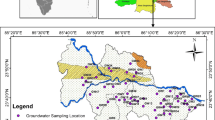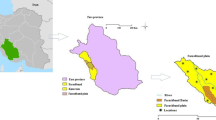Abstract
Hygienic drinking water is limited, not only in India, but also worldwide. Groundwater is a major source for domestic and irrigation use in the area of the Mandvi River basin, Andhra Pradesh, India. Therefore, this paper is mainly focused on it. In this study, 55 groundwater samples were collected and various geochemical parameters were analyzed, such as pH, electrical conductivity (EC), total dissolved solids (TDS), carbonates, bicarbonates, chlorides, sulfates, hardness, alkalinity, fluoride, magnesium, calcium, sodium, potassium, and nitrate. From the analysis, results are interpreted with various geochemical indices such as sodium absorption ratio (SAR), potential salinity (Ps), residual sodium carbonate (RSC), non-carbonate hardness (NCH), permeability index (PI), Kelly’s ratio (KR), magnesium ratio (MR) and percent sodium (PS). From Chadha’s geochemical classification, most of the sample’s hydrochemical facies were Na–Cl (66%) and Ca–Mg–Cl (20%). The results of the study showed that 12.5% and 51.7% of the groundwater samples exceeded the permissible limits for fluoride and nitrate, respectively. Hence, all these interpretations indicated that most of the groundwater samples are not suitable for domestic and irrigation use. Rainwater harvesting, water quality improvement plans, regular monitoring of water quality, and multidisciplinary water research programs are recommended as measures for sustainable groundwater management in the study area.









Similar content being viewed by others
References
APHA. (2005). Standard methods for the examination of water and waste-water (20th ed.). Washington: American Public Health Association.
Balaji, E., Nagaraju, A., Sreedhar, Y., Thejaswi, A., & Sharifi, Z. (2017). Hydrochemical characterization of groundwater in around Tirupati area, Chittoor district, Andhra Pradesh South India. Applied Water Science, 7, 1203–1212. https://doi.org/10.1007/s13201-016-0448-6
BIS. (2012). Indian standard drinking water specification, second revision IS 10500:2012. New Delhi: Bureau of Indian Standards, Drinking Water Sectional Committee. FAD25.
Bouwer, H. (1978). Groundwater hydrology (No. 04; GB1003 2, B6). Mexico: McGraw-Hill.
Brindha, K., Rajesh, R., Murugan, R., & Elango, L. (2011). Fluoride contamination in groundwater in parts of Nalgonda district, Andhra Pradesh India. Environmental Monitoring and Assessment, 172, 481–492. https://doi.org/10.1007/s10661-010-1348-0
Chadha, D. (1999). A proposed new diagram for geochemical classification of natural waters and interpretation of chemical data. Hydrogeology Journal, 7, 431–439. https://doi.org/10.1007/s100400050216
Doneen, L. D. (1964). Water quality for agriculture. Davis: University of California.
Durov, S. A. (1948). Natural waters and graphic representation of their composition. Doklady Akademii Nauk SSSR, 59, 87–90.
Eaton, F. M. (1950). Significance of carbonates in irrigation waters. Soil Science, 69, 123–134. https://doi.org/10.1097/00010694-195002000-00004
Gibbs, R. J. (1970). Mechanisms controlling world water chemistry. Science, 170(3962), 1088–1090. https://doi.org/10.1126/science
Kawo, N. S., & Karuppannan, S. (2018). Groundwater quality assessment using water quality index and GIS technique in Modjo River Basin, central Ethiopia. Journal of African Earth Science, 147, 300–311. https://doi.org/10.1016/j.jafrearsci.2018.06.034
Kelly, W. P. (1963). Use of saline irrigation water. Soil Science, 95(4), 355–391.
Moosavirad, S. M., Janardhana, M. R., & Khairy, H. (2013). Impact of anthropogenic activities on the chemistry and quality of groundwater: A case study from a terrain near Zarand City, Kerman Province SE Iran. Environmental Earth Sciences, 69, 2451–2467. https://doi.org/10.1007/s12665-012-2072-6
Nagaraju, A., Sunil Kumar, K., Thejaswi, A., & Sharifi, Z. (2014). Statistical analysis of the hydrogeochemical evolution of groundwater in the Rangampeta area, Chittoor District, Andhra Pradesh, South India. American Journal of Water Resources, 2(3), 63–70. https://doi.org/10.12691/ajwr-2-3-2
Piper, A. M. (1944). A graphical procedure in the geochemical interpretation of water analysis. Transactions American Geophysical Union, 25, 914–928.
Rajesh, R., Karthikeyan, B., & Elango, L. (2015). Groundwater quality and its hydrochemical characteristics in a shallow weathered rock aquifer of southern India. Water Quality, Exposure and Health, 7(4), 515–524. https://doi.org/10.1007/s12403-015-0166-6
Rao, N. S., Dinakar, A., Sravanthi, M., & Karunakumari, B. (2021). Geochemical characteristics and quality of groundwater evaluation for drinking, irrigation, and industrial purposes from a part of hard rock aquifer of South India. Environmental Science and Pollution Research, 28, 31941–31961. https://doi.org/10.1007/s11356-021-12404-z
Sawyer, C. N., & McCarty, P. L. (1978). Chemistry of environmental engineering. Series in water resources and environmental engineering (3rd ed., p. 532). New York: McGraw–Hill publisher.
Shrestha, S., & Kazama, F. (2007). Assessment of surface water quality using multivariate statistical techniques: A case study of the Fuji river basin, Japan. Environmental Modelling & Software, 22, 464–475. https://doi.org/10.1016/j.envsoft.2006.02.001
Siddiraju, R., Sudarsana Raju, G., & Rajasekhar, M. (2019). Identification of groundwater potential zones in Mandavi River basin Andhra Pradesh, India using remote sensing, GIS and MIF techniques. HydroResearch, 2, 1–11. https://doi.org/10.1016/j.hydres.2019.09.001
Szabolcs, I., & Darab, C. (1964). The influence of irrigation water of high sodium carbonate content of soils. Proceedings of 8th ISSS Trans, 2:802–812.
Todd, D. K. (1980). Groundwater hydrology (2nd ed., p. 535). Wiley.
Tripathi, A. K., Mishra, U. K., Mishra, A., & Dubey, P. (2012). Assessment of groundwater quality Gurh Tehseel, Rewa District Madhya Pradesh India. International Journal of Scientific and Engineering Research, 3(9), 1–12.
US Salinity Laboratory Staff. (1954). Diagnosis and improvement of saline and alkali soils (p. 160). Washington: US Department of Agriculture Handbook no. 60.
WHO. (2008). pH in drinking water, Revised background documents for development of WHO guidelines for drinking water quality. World Health Organisation
Wilcox, L. V. (1955). Classification and use of irrigation waters. Circular 969. Washington: USDA Publisher.
World Bank report: deep wells and prudence India groundwater: a valuable but diminishing resource dated March 6, 2012 https://www.worldbank.org/en/news/feature/2012/03/06/india-groundwater-critical-diminishing.
Acknowledgements
The first author Dr. R. Siddi Raju, Inspire fellow [150036], is greatly thankful to the Department of Science and Technology for providing financial support. (No. DST/INSPIREFELLOWSHIP/REL5/2013/C1 Settlement GOVERNMENT OF INDIA MINISTRY OF SCIENCE & TECHNOLOGY DEPARTMENT OF SCIENCE & TECHNOLOGY, the 5th installment of grant under “General Component. Dated: 01.08.2018)
Author information
Authors and Affiliations
Corresponding author
Ethics declarations
Conflict of interest
There is no conflicts of interest to my research.
Supplementary Information
Below is the link to the electronic supplementary material.
Rights and permissions
About this article
Cite this article
Siddi Raju, R., Sudarsana Raju, G. & Rajasekhar, M. Assessment of groundwater quality in hard rock terrain of Mandavi River basin, Rayalaseema region, Andhra Pradesh, India. Int J Energ Water Res 6, 371–388 (2022). https://doi.org/10.1007/s42108-021-00165-x
Received:
Accepted:
Published:
Issue Date:
DOI: https://doi.org/10.1007/s42108-021-00165-x




